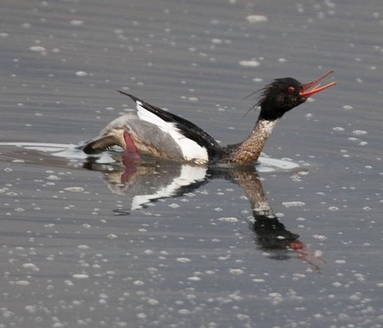Red-breasted Merganser

Arran is a site of national importance for this handsome sawbill diving duck. The name "sawbill" refers to the fact that the bill has tooth like lamellae along the cutting edges of its bill, enabling better grip of its main prey, fish. The Red-breasted Merganser is a widespread and a relatively common breeding species, found all year round on the coast. In winter the resident birds are joined by immigrants, including birds from Iceland and Fennoscandia.
Mergansers in all plumages are characterised by a somewhat smart casual look. The shaggy crest and upswept bill add to their eccentrically untidy appearance. Female and immature birds are known as red-heads.
The Red-breasted Mergansers' courtship display on a calm sea is a joy to behold, particularly when a group of males vie with each other showing off their charms of movement, voice and plumage before a single female. The male begins by stretching his long neck so that the white ring is broadened and the metallic green head with its crest and narrow red bill become very prominent. At once the bill is opened and the male bobs in such a way that the breast and lower part of the neck are immersed while the tail
and posterior part of the bird swing up. All the motions are quickly and stiffly executed and suggest a formal but ungraceful courtesy. The dominant male will usually try to position himself directly in front of the female but there is much jockeying for position.
This display starts in the late winter and the proportion of birds paired increases to a peak in late April when they enter their breeding grounds. Mergansers breed late so that their young can exploit the seasonal abundance of tiny shoaling fish available in mid-to late summer. Merganser males start to body moult in May and leave for the moulting areas as the females start incubation. The seven to twelve ducklings hatch in June and July and leave the nest scrape within a couple of days. Females look after the young and amalgamation of broods is not unusual. There is a high loss among the young. Large gulls are major predators. Surviving ducklings fledge in August. Adult mergansers moult their flight feathers in August and September, congregating in open areas of shallow waters like Machrie Bay where there is an abundance of small shoaling fish and shrimp and some security during their four weeks of flightlessness. After the moult the birds are in breeding plumage again ready for the next round of displays.